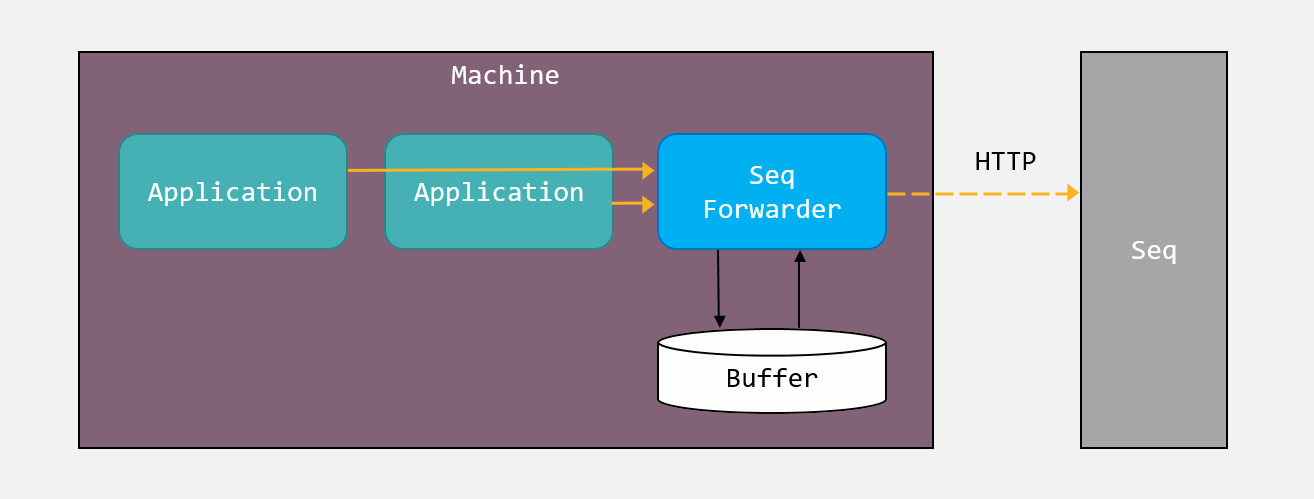Seq Forwarder is a client-side log collector that receives events over its local HTTP API and persists them to its own internal storage until a remote Seq server can be reached.
Seq Forwarder listens on port 15341 by default. The HTTP ingestion API is identical to
the Seq one, so standard client libraries like Serilog.Sinks.Seq can write to
it directly.
Log.Logger = new LoggerConfiguration()
.WriteTo.Seq("http://localhost:15341")
.CreateLogger();
Log.Information("Hello, Seq Forwarder!"); Client applications can specify an API key when logging to Seq Forwarder. In this case the API key supplied by the client will be forwarded along to the target Seq server.
Alternatively, Seq Forwarder can be configured with an API key, and will use this to log to Seq when client applications do not specify one.
First, download the release bundle for your platform, and extract it to a suitable location.
The instructions below use the seqfwd command-line. To learn about available commands, try seqfwd help.
To set up Seq Forwarder as a Windows service, from an administrative PowerShell prompt in the Seq Forwarder directory, set the target Seq server URL and an optional API key:
./seqfwd config -k output.serverUrl --value="http://seq.example.com/"
./seqfwd config -k output.apiKey --value="1a2b3c4d5e6f"
./seqfwd config -k storage.bufferSizeBytes -v 1073741824
./seqfwd install
./seqfwd startThe default buffer size limit is 64 MB. In the example, this is increased to 1 GB.
To upgrade, stop the service, overwrite the forwarder release bundle, and restart the service.
On Windows, Seq Forwarder will used machine-scoped DPAPI to encrypt the default API key and any API keys supplied by clients.
On Linux, you'll need liblmdb:
apt install liblmdb-dev
To run Seq Forwarder, configure the target Seq server URL, and optionally, an API key:
./seqfwd config -k output.serverUrl --value="http://seq.example.com/"
./seqfwd config -k output.apiKey --value="1a2b3c4d5e6f"
./seqfwd config -k storage.bufferSizeBytes -v 1073741824
./seqfwd runNote that on macOS and Linux, the output API key and any API keys provided by clients will be stored in plain text.
The default buffer size cap is 64 MB. In the example, this is increased to 1 GB.
Seq Forwarder is a .NET Core application that can be built using the .NET Core SDK on Windows, macOS, and Linux.
To debug, F5 will work, but on Windows you will need to either run the install command (see below) to create an HTTP namespace
reservation, or run as Administrator.
By default the "forwarder" logs will be stored under %PROGRAMDATA%\Seq\Logs. If the destination Seq server is not
available, an exception will be stored in these log files.
If you need to inspect the current configuration, it can be found at: %PROGRAMDATA%\Seq\Forwarder\SeqForwarder.json
> ./seqfwd help
Usage: seqfwd <command> [<args>]
Available commands are:
bind-ssl Bind an installed SSL certificate to an HTTPS port served by Seq
Forwarder
config View and set fields in the SeqForwarder.json file; run with no
arguments to list all fields
dump Print the complete log buffer contents as JSON
help Show information about available commands
install Install the Seq Forwarder as a Windows service
restart Restart the Windows service
run Run the server interactively
start Start the Windows service
status Show the status of the Seq Forwarder service
stop Stop the Windows service
truncate Clear the log buffer contents
uninstall Uninstall the Windows service
version Print the current executable version
Note that the Windows HTTP and service-related commands (bind-ssl, install, restart, start, status, stop,
and uninstall) are only available on that platform.
The seqfwd config command reads and writes SeqForwarder.json:
{
"diagnostics": {
"internalLogPath": "C:\\ProgramData\\Seq\\Logs\\",
"internalLoggingLevel": "Information"
},
"output": {
"serverUrl": "http://localhost:5341",
"eventBodyLimitBytes": 262144,
"rawPayloadLimitBytes": 10485760,
"apiKey": null
},
"storage": {
"bufferSizeBytes": 67108864
},
"api": {
"listenUri": "http://localhost:15341"
}
}On Windows, this file lives in C:\ProgramData\Seq\Forwarder.


